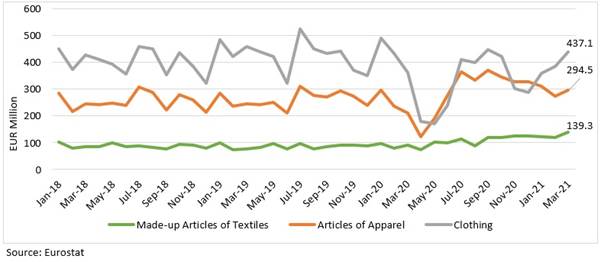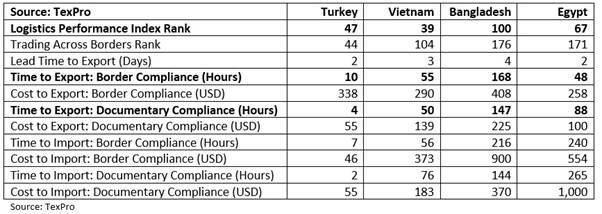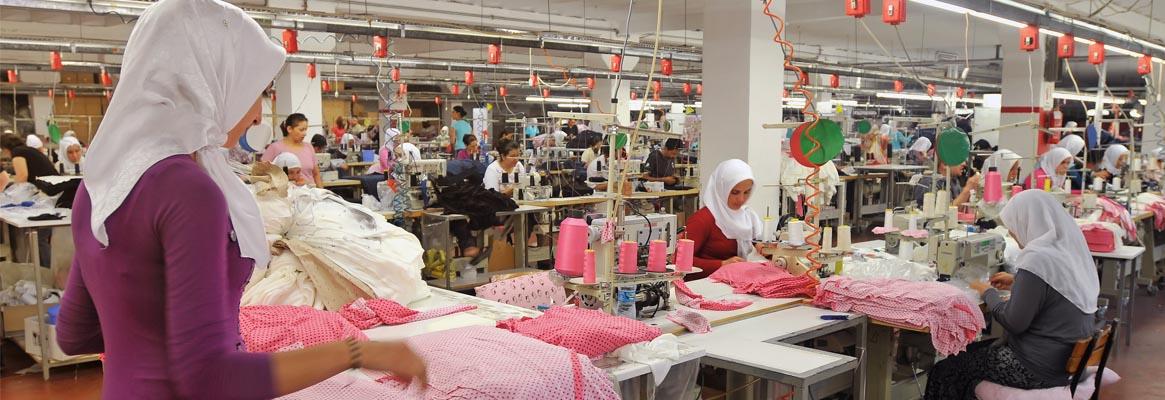Turkey is grabbing limelight as one of the possible alternatives to China in the global textile value chains. While, Turkey has shown great promise over the last two decades with rapidly growing GDP and exports, its economic performance is slowing down. Reforms are needed to address challenges related to Turkey's textile industry and put it back on track.
Turkey's textile sector has been much in talks recently due to the potential it holds for becoming a significant sourcing location for global apparel chains. Global brands, particularly those in the EU, have already started placing orders in increasing numbers after their conscious shift from doing business with China. This has resulted because of two reasons. Firstly, multinational companies were already on the lookout for a sourcing alternative to China-a movement which got aggravated due to the political spat between China and EU in March this year and more recently because of issues related to Xinjiang and production using forced labour. Secondly, in the aftermath of Covid, European companies prefer near-shoring as one of the ways to diversify supply chains and make them more flexible and efficient. According to a survey of sourcing executives, jointly conducted by McKinsey and Sourcing Journal last year, 60 per cent of respondents "expect at-scale and highly capable apparel-manufacturing clusters to emerge" in nearshore markets around Central Asia or Eastern Europe.
Turkey has been a large beneficiary of this shift in trade flows. It has also received this well as it has been quick to supply the increased demand in a market which faces tough competition from relatively more cost-effective nations like Vietnam and Bangladesh. Turkey's total apparel exports in Apr 2021, increased to USD 1.6 billion up from USD 573 million last year. During Jan-Apr 2021, Turkey's total apparel exports increased to USD 6.3 billion from USD 4.8 billion last year, a 32.3 per cent rise (Source: Turkish Exporters Assembly). EU's imports from Turkey have also recovered with tremendous speed, post the recovery from Covid induced decline in demand. Turkey has the largest shares in EUs imports for apparel, clothing and accessories and made-up articles (mostly home textiles), an average of 7.0 per cent across these product categories. EUs imports of apparel, clothing and made-up articles from Turkey have grown beyond pre-pandemic levels, however, imports of apparel and clothing are yet to breach the previous peaks.
Figure 1: EU imports from Turkey of select product categories

These categories are likely to see an even larger increase in European imports from Turkey, as it is one of the largest suppliers of these categories to EU and face competition majorly from Bangladesh and China. This is more likely, particularly in clothing accessories, where Turkey holds 8.6 per cent share after Italy's 9 per cent and China's mammoth 29.9 per cent share. When it comes to clothing imports to the EU, Turkey has a larger share in woven clothes than knitwear, while on the contrary, Turkey's overall woven clothes exports are just three quarters of its overall exports of knitted clothes. Turkey's knitted apparel has historically lost significant share to Vietnam and Bangladesh, especially in women's clothing, where as its share has gone down from 4.9 per cent in 2000 to 3.5 per cent in 2019. Vietnam constitutes 7.4 per cent of global exports, while Bangladesh holds 4.4 per cent share in global exports of women's knitted clothing. For men's knitted clothing, Turkey's share has stagnated around 2.0 per cent in the last 20 years. Turkey's exports of knitted apparel grew by a meagre 1.3 per cent during 2011-19, while woven apparel exports grew by 3.4 per cent. EU's imports of knitted apparel, on the other hand, have grown by almost 4.0 per cent during the same period. With sourcing preferences shifting from China significantly, and near-shoring more likely to become the norm, Turkey's knitted apparel exports may see some renewed demand from many European brands.
While textile and apparel industries outside China is expected to reap large benefits from the shift in trade patterns, countries will have to compete aggressively on economic progress, infrastructure growth and ease of doing business to attract investments and maintain economic and political stability to ensure lesser risk to businesses. Here, a discussion of Turkey's economic performance becomes imminent and what could be the likely challenges it will face towards increasing its presence in global textile and apparel value chains.
Turkey's economic performance over the years
Turkey's economic growth over the last two decades has been noteworthy. Having per-capita GDP of USD 3,143 in 2000, it managed to increase its per-capita GDP to USD 12,614 by 2013. That trend has however reversed since then, as its per-capita GDP has now fallen to USD 9,126 in 2019. This has largely been due to a decline in its GDP and a rising population. This is important as high growth (or just sustained low growth) attracts investments and leads to greater integration in global value chains.
World Economic Forum informs that Turkey's transformational growth in the first decade of this century was largely due to institutional reforms, which were focused on maintaining its price, currency and fiscal stability. The economic and political stability led to improvement in EU-Turkey relations, which also saw a tremendous rise in trade flows between the two economies. Turkey's overall exports to EU went from USD 15.8 billion in 2000 to USD 63.3 billion in 2011, a 13.0 per cent increase per year on average. This was most likely a consequence of large productivity growth during this period, with almost a doubling of private sector investment to GDP ratio in Turkey's economy, from 12.0 per cent in 2000 to slightly more than 22.0 per cent in 2006, sliding thereafter (Source: TURKSTAT).
Economic growth post 2012-13 has declined tremendously. Consumer price inflation in Turkey subsided from 54.4 per cent in 2001 to 6.5 per cent in 2011, but that has also eventually moved upwards post-2015, and recorded 15.1 per cent in 2019. The rise in prices has partially resulted from continued depreciation of Turkish Lira against the USD, from an exchange rate of 1.5 Lira/USD in 2010 to 7.0 Lira/USD in 2020, lowest being at 7.9 Lira/USD at one point. Although, currency depreciation is considered a boon for a country's exports, but consistent decline in value, with no clear policy for stability, could lead to a loss of confidence in the currency. Rising inflation, declining economic growth and currency instability have been challenging Turkey's economic progress. Although, Turkey grew 1.8 per cent despite the pandemic in 2020, it was largely backed by steep credit growth. With higher inflation, increasing foreign debt and low economic growth, credit growth would also become a less viable solution to push economic growth any further.
However, despite a sliding economic growth, investors' interest in the Turkish economy has not waned and only increased. By any measure of comparison, FDI flows have on average remained similar or increased slightly over the years. If we compare the two periods 2001-10 and 2011-19, total FDI inflows to Turkey in the latter period were USD 121.5 billion vis-a-vis USD 98.7 in the former. Also, considering the period post 2015, during 2015-19, total FDI inflows were USD 65.2 billion vs USD 65.4 billion during 2010-14.
Textile and apparel industry in Turkey
Turkey's textile and apparel industry have been instrumental to its economic growth and development over the years. At its peak in 2002, textile and clothing contributed 26.6 per cent to total manufacturing value-added in Turkey. This share has gradually come down to 17.7 per cent in 2013 and 16.4 per cent in 2018, still remaining very significant. Around 20 per cent of the 500 largest companies in the country are involved in this industry. A large part of the Turkish workforce, close to 1.63 million people, is also employed in this industry.
Turkey's textile sector also contributes tremendously to its export earnings, representing more than 18.0 per cent of its exports. Its major export partners include the EU countries, UK, US, Iraq and Saudi Arabia among the top 5. Total FDI inflows into the textile manufacturing sector in Turkey amounted to USD 1.8 billion during 2006-15. The textile and clothing market in Turkey also remains a large market for global textile related exports. EU being its largest import partner as well, sent more than USD 2.5 billion worth of goods to Turkey.
Turkey has a distinct advantage of domestically supplying a significant portion of its textile and apparel industry. This is more prominent in the cotton industry. Turkey produces more than 62.0 per cent of its cotton consumption needs (Source: USDA), while its large cotton spinning industry processes the cotton and supplies almost 85 per cent of its domestic cotton yarn consumption. On the fabric front as well, Turkey exports almost twice the amount of cotton fabric it imports from the world. Majority of Turkey's dependence on imports for raw materials is in synthetic fibres and yarn, of which majority is supplied by China and India.
Textile and clothing demand from the European countries has helped the Turkish industry grow much faster. EU constitutes more than 60 per cent of Turkey's textile and clothing exports. Turkey's close integration with Europe has helped its rise in the recent years as a large probable sourcing location. Turkey has an advantage of being located close to Europe, but its high labour costs make Vietnam and Bangladesh tough competitors. Yet the quality of goods, proximity to border (reduced lead time), similar fashion trends as Europe, and a largely domestically supplied industry are the biggest positives of the Turkish textile and clothing sector.
Turkey's textile dreams: Defining factors
Let us take a closer look at some factors that can make or break Turkey's textile dreams in the future:
a) Economic Stability: Consistently declining economic growth puts pressures on businesses as their plans for increasing capacity and their profitability is adversely impacted. Turkey's economy saw immense economic gains during the period 2000-13, and the progress now appears to be waning. Rising inflation and currency pressures could only add to its challenges to again grow at double-digits. Competing nations such as Vietnam and Bangladesh are fitting examples of how you do economic stability right. The pandemic has revealed how economic shocks can harm any nation, and most surely one whose economy is dwindling. Getting economic growth and price stability back on track will be crucial for the global supply chains to rely on Turkey to play a much larger role.
b) Production & trade costs: Turkey has much higher labour costs than other competing nations. Data from TexPro shows that in 2020, average wage in Turkey was USD 298.7 per month, vis-�-vis USD 159.3 in Vietnam, USD 94.2 in Bangladesh, USD 221.9 in China and 126.7 in Egypt. While, wages are something the nations can't do much about, reducing costs in terms of logistics and transportation can be crucial to maintaining Turkey's competitive advantage in the global value chains. TexPro data on regulatory and logistics comparison shows that Turkey ranks superior to Vietnam, Bangladesh and Egypt, in terms of lead time and hours taken for border compliances, even though in terms of dollar costs it might be equally competitive. Bringing down monetary costs as well for border compliance will only work to Turkey's advantage.
Table 1: Performance of peer countries on logistics indicators

c) Proximity of location: Turkey's close proximity to Europe and also to the US may have worked to its advantage, but other textile centers in the region such as Egypt are catching up fast. Increasing trade ties between Europe, US on one side and Vietnam and Bangladesh on the other, implies that proximity is just one aspect of the trade. Also, large Chinese investments in textile industries of Egypt and Ethiopia would result in providing massive scale advantages to these countries, further belittling Turkey's location dynamics. It will only be fruitful to create greater network economies, building on its vertically integrated supply chain to increase the scale of its textile industry and increase its competitiveness globally. Attracting enormous amounts of foreign investment will also be key to this process.
d) Large push for sustainability: Turkey is one of the top suppliers of organic cotton today. As of 2020, Turkey shared the third position with Kyrgyzstan, both having a 10 per cent share. With pressure on apparel chains to replace Xinjiang cotton, organic cotton from India, Kyrgyzstan and Turkey is going see to a greater jump in demand. Turkey is also one of the few countries in the world which have prohibited the use of genetically modified organisms in agriculture, rendering the quality of its cotton much finer, while also maintaining its farm productivity as one of the highest in the world. Global buyers of Turkish cotton are known to pay more for Turkish cotton for its better cotton quality (Source: Textile Exchange Organic Cotton Market Report, 2020). Going forward, the focus on sustainability of materials and supply chains will be much larger, giving Turkey an early mover advantage.
The recent trade shifts out of China are expected to benefit many competing nations. The sector will become relatively more dynamic and diversified as China sheds a significant part of its share in the global value chain. Economies such as Turkey will have a lot to gain from this shift. Turkey has built its economy largely on its trade relations with the EU, and its textile and apparel industry plays a huge role in it. With increasing competition and changing global dynamics, Turkey must take measures to maintain its semblance in the global textile value chain.








Comments